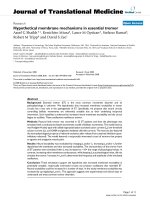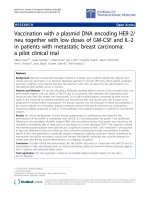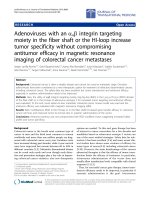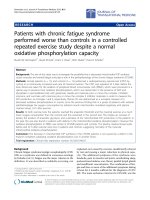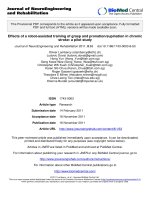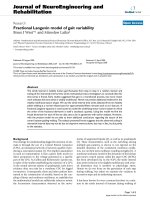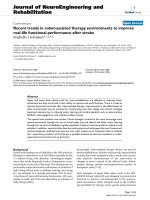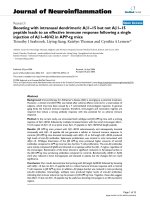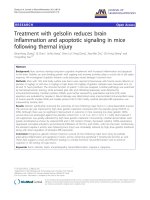Báo cáo hóa học: " Improving TCP Performance over Wireless Ad Hoc Networks with Busy Tone Assisted Scheme" pdf
Bạn đang xem bản rút gọn của tài liệu. Xem và tải ngay bản đầy đủ của tài liệu tại đây (921.59 KB, 11 trang )
Hindawi Publishing Corporation
EURASIP Journal on Wireless Communications and Networking
Volume 2006, Article ID 51610, Pages 1–11
DOI 10.1155/WCN/2006/51610
Improving TCP Performance over Wireless Ad Hoc
Networks with Busy Tone Assisted Scheme
Qi He,
1
Lin Cai,
2
Xuemin (Sherman) Shen,
3
and Pinhan Ho
3
1
Research In Motion (RIM), Ottawa, ON, Canada, K2K 3K2
2
Department of Electrical and Computer Engineering, Faculty of Engineering, University of Victoria,
Victoria, BC, Canada, V8W 3P6
3
Department of Electrical and Computer Engineering, Faculty of Engineering, University of Waterloo,
Waterloo, ON, Canada, N2L 3G1
Received 1 August 2005; Revised 29 December 2005; Accepted 29 December 2005
It is well known that tr ansmission control protocol (TCP) performance degrades severely in IEEE 802.11-basedwirelessadhoc
networks. We first identify two critical issues leading to the TCP performance degradation: (1) unreliable broadcast, since broadcast
frames are transmitted without the request-to-send and clear-to-send (RTS/CTS) dialog and Data/ACK handshake, so they are
vulnerable to the hidden terminal problem; and (2) false link failure which occurs when a node cannot successfully transmit data
temporarily due to medium contention. We then propose a scheme to use a narrow-bandwidth, out-of-band busy tone channel to
make reservation for broadcast and link error detection frames only. The proposed scheme is simple and power efficient, because
only the sender needs to transmit two short messages in the busy tone channel before sending broadcast or link error detection
frames in the data channel. Analytical results show that the proposed scheme can dramatically reduce the collision probability
of broadcast and link error detection frames. Extensive simulations with different network topologies further demonstrate that
the proposed scheme can improve TCP throughput by 23% to 150%, depending on user mobility, and effectively enhance both
short-term and long-term fairness among coexisting TCP flows in multihop wireless ad hoc networks.
Copyright © 2006 Qi He et al. This is an open access article distributed under the Creative Commons Attribution License, which
permits unrestricted use, distribution, and reproduction in any medium, provided the original work is properly cited.
1. INTRODUCTION
It is well known that TCP performance degrades significantly
in IEEE 802.11-based multihop wireless ad hoc networks [1–
5] due to the TCP instability problem and the unfairness
problem. The former may cause dramatic drop of the TCP
throughput to zero, while the latter may lead to substantial
throughput variation of the coexisting TCP flows. These two
problems are closely related to the unreliable broadcast and
the false link failure.
In ad hoc networks, there is no request-to-send/clear-to-
send (RTS/CTS) to reserve channels and to avoid the hid-
den terminal problem for broadcast frames. In addition, no
Data/ACK handshake has been devised for the sender to dis-
tinguish whether the broadcast is successful or not. Since
many important network management and control signal-
ing messages are delivered by broadcast in ad hoc networks,
for example, the Address Resolution Protocol (ARP) request
messages a nd route request messages, the low success rate
of broadcast transmissions may significantly downgrade the
whole network functionality and efficiency.
On the other hand, when a node (sender) fails to transmit
data to its next-hop receiver for a certain period of time, the
node simply assumes that the link is broken. The source node
(in this paper, the sender refers to the node who transmits or
broadcasts to its one-hop neighbors, and the source node is
the node who transfers data through an end-to-end connec-
tion) is thus notified to discover a new route to the desti-
nation based on the assumption that the link failure event is
due to user mobility and node failure, and so forth. However,
a link failure event can be caused not only by user mobility
and node failure, but also by link-layer contention. The later
case is also referred to as the false link failure, where the in-
termediate node that fails to relay the data will also inform
the source node to discover a new route by mistakenly as-
suming that the link is broken. The route discovering proce-
dure is very time consuming and imposes great overhead to
the network. The procedure also relies on broadcast, and a
low success rate of broadcast transmissions will prolong the
route discovering procedure.
These two problems interact with TCP’s congestion con-
trol mechanism (window backoff and timeout), and have
2 EURASIP Journal on Wireless Communications and Networking
AB
RTS
CD
Data
Figure 1: False link failure.
significant impact on TCP performance. Thus, to enhance
TCP performance in the ad hoc networks, it is critically
important to improve the success rate of broadcast trans-
missions and to detect and recover from false link failures
promptly. Since it is impractical to use RTS/CTS for broad-
cast and link error detection frames, we propose to send
control messages in a narrow-bandwidth, out-of-band chan-
nel, called busy tone channel, to reserve the data channel for
broadcast and link error detection frames only.
Busy tone assisted schemes have been proposed in the lit-
erature for different purposes. In [6], a receiver-initiated busy
tone scheme was proposed, where receivers set up busy tone
during the receiving p eriod to prevent tr ansmission from
hidden terminals. The receiver-initiated scheme is not ap-
plicable for both the broadcast frame which potentially has
multiple receivers and the link error detection frame which
may have no receiver at all . A dual busy tone scheme was
proposed in [7], which uses two busy tone channels together
with the RTS/CTS scheme to solve the hidden terminal and
exposed terminal problems for unicast transmissions. This
scheme requires both the sender and the receiver transmit-
ting in two busy tone channels to protect RTS and data pack-
ets, and it is not suitable to protect the broadcast frame and
the link error detection frame. Different from the previous
approaches, our scheme allows the sender to send short con-
trol messages in the busy tone channel to protect broadcast
and link error detection frames.
The main contributions of this paper are as follows.
First, we propose a busy tone assisted broadcast and link er-
ror detection scheme with low overhead and good energy-
efficiency, where only the sender needs to transmit two short
messages in the busy tone channel before sending broad-
cast or link error detection frames in the data channel. Sec-
ond, the success rates of the broadcast and link error de-
tection frames a re evaluated for both the proposed scheme
and the standard IEEE 802.11 scheme. Numerical results
demonstrate that the proposed scheme can effectively en-
hance the success rate of broadcast and link error detection
frames. Third, by using NS-2, the TCP performances with
and without using the proposed scheme are evaluated. Ex-
tensive simulation results with different network topologies
demonstrate that the proposed scheme can improve TCP
throughput by 23% to 150%, for both high-mobility and
low-mobility cases, and enhance both short-term and long-
term fairness among coexisting TCP flows in multihop wire-
less ad hoc networks.
The rest of the paper is organized as follows. Section 2
gives a brief introduction on the system model by discussing
two severe problems in IEEE 802.11-based ad hoc networks
and their negative impacts on TCP performance due to us-
ing a single channel. The busy tone assisted scheme is pre-
sented in Section 3, followed by its performance analysis in
Section 4.InSection 5, simulation results are given to verify
the per formance gain of the proposed scheme. Related work
is discussed in Section 6 and Section 7 concludes the paper.
2. SYSTEM MODEL
In the IEEE 802.11 standard, a wireless ad hoc network is de-
fined as an independent basic service set (IBSS) deploying
the distributed-coordination-function-(DCF-) based carrier
sense multiple access with collision avoidance (CSMA/CA)
medium access mechanism. CSMA/CA is effective and effi-
cient in single-hop wireless networks such as infrastructure-
based WLANs. However, it faces great challenges in the mul-
tihop scenarios. Here, we identify two problems, the un-
reliable broadcast problem and the false link failure prob-
lem, which result in the most serious impact on TCP per-
formance.
2.1. Unreliable broadcast
Broadcast is very important in carrying critical information
in the network, such as the routing information, ARP mes-
sage, and node advertisement message, and so forth. Unlike
wired networks, it is very difficult to provide reliable broad-
cast in wireless ad hoc networks due to the high bit error
rate, wireless medium contention, and so forth. In the IEEE
802.11 standard, since no RTS/CTS is devised for broadcast
frames, comparing with unicast frames, broadcast frames are
more vulnerable to the hidden terminal problem. Further-
more, unlike unicast frames, there is no Data/ACK hand-
shake for broadcast frames. Therefore, the broadcast senders
cannot tell whether the broadcast frame is correctly received
by all intended receivers or not.
If broadcast fails, some important network functions
may fail. For instance, a route failure may happen if either the
broadcast ARP request message or the route request message
fails to be delivered. Consequently, the data transmission is
frozen. Therefore, how to provide reliable broadcast in wire-
less ad hoc networks is critical.
2.2. False link failure
Link failure in wireless ad hoc networks may be due to node
mobility, power attenuation, node failure, all of which can
discontinue the sender forwarding packets to the next hop,
and lead to the source searching for a new route to the desti-
nation. However, if a sender fails to transmit a frame due to
link contentions, the source node may unnecessarily start to
search for a new route by assuming a link failure event. We
call it false link failure, as illustrated below.
As shown in Figure 1, node A attempts to transmit a data
frame to node B while node C is transmitting a data fr a me
to node D. Since node C is out of the carrier sensing range
of node A, node A tr i es to send RTS to node B. Node B can-
not receive the RTS frame successfully due to the collision
with the data frame sent by node C. Thereafter, node A re-
transmits the RTS using an exponential backoff algorithm.
Qi He et al. 3
ABCDEF
RTS Data
Figure 2: TCP instability problem.
However, since the transmission time of a data packet (e.g.,
with 1500 bytes) is usually much larger than the transmission
time of the RTS (about 20 bytes), node A may fail to send RTS
to node B for several times consecutively. Thus, false link fail-
ure may happen even when the traffic load is not heavy. Since
all routes via this link need to be recalculated, false link fail-
ures bring significant overhead to the network.
2.3. Impacts on TCP performance
TCP faces two major problems in ad hoc networks, which
are not encountered in wired networks [1–5]. The first is
the throughput instability problem: the throughput of a TCP
flow fluctuates severely and even frequently drops to zero.
The second is the unfairness problem: when there are sev-
eral TCP flows competing in the network, some flows tend to
dominate the channel and the other flows are starved, even
when all nodes are static. By examining the interactions be-
tween TCP and the IEEE 802.11 MAC protocol, the false link
failure problem and unreliable broadcast problem play an
important role for both the TCP instability problem and the
unfairness problem.
(1) TCP instability problem
As shown in Figure 2, a TCP connection is established be-
tween node A and node F. When node D is transmitting a
frame to node E, since the transmission is out of the sensing
range of node B, node B attempts to send RTS to node C. At
node C, the RTS sent by node B collides with the packet sent
by node D. After retransmitting RTS seven times, node B as-
sumes that a link failure occurs, which is a ty pical false link
failure event.
Thereafter, the intermediate nodes discard all packets
transmitted via the route and notify the source node of the
route failure. The source node then broadcasts a route re-
quest message to search for a new route. Here, we consider
Dynamic Source Routing (DSR) protocol as an example.
Furthermore, due to the unreliable broadcast problem, the
broadcast route request message and ARP request message
can easily get lost due to link-layer contention. If either the
route request message or ARP request message is lost, the
new route cannot be established successfully.
As an on-demand routing protocol, DSR searches for a
new route only when any packet is ready to be sent. On the
other hand, TCP will retransmit the packet until the cur-
rent tr ansmission timeouts. TCP exponentially increases the
timeout value after each retransmission. Therefore, it may
take a fairly long time (several seconds) to resume the TCP
transmission when a route failure happens. Until a new route
is established successfully, the TCP sending rate drops to zero,
leading to the TCP instability problem.
ABCD
E
F
RTS
Data
Figure 3: TCP unfairness problem.
(2) TCP unfairness problem
TCP suffers from severe unfairness problem due to many fac-
tors, such as hidden terminal and exposed terminal prob-
lems, capture effect, the adoption of the binary exponential
backoff (BEB) scheme, and variation of hop lengths, and so
forth. Besides, the false link failure and unreliable broadcast
in the MAC layer that may cause serious impacts on the TCP
throughput performance have not been fully addressed in the
literature.
As illustrated in Figure 3, there are two flows competing
with each other: flow 1 between node A and node D, and
flow 2 between node E and node F. Due to the collision of
the RTS (sent by node A) and the data frame (sent by node
E), node A may trigger route failure. Due to the unreliable
broadcast problem, it takes a long time for flow 1 to establish
a new route and resume transmission. During this period,
flow 2 completely captures the channel, which causes severe
unfairness.
2.4. Why single channel is not sufficient
Since the RTS/CTS scheme is not applicable for broadcast
transmission, is it possible to increase the carrier sensing
range, to avoid the hidden terminal problem? To discuss this
issue, we first define the transmission range, sensing range,
and interference range as below [8].
The transmission range is the range (with respect to the
transmitting station) within which a transmitted frame can
be successfully received by receivers. The physical carrier
sensing range is the range within which the signal-to-noise-
ratio (SNR) is greater than or equal to the threshold by which
the other stations can detect the transmission. The interfer-
ence range is the range within which any station in the re-
ceiving mode can be interfered with the transmitter and thus
loss of the packets. The interference range is usually larger
than the transmission range, and it is a function of the dis-
tance between the sender and receiver.
To avoid the hidden terminal problem, the carrier sens-
ing range should be set to be larger than the maximum in-
terference range plus the transmission range. However, the
sensing range is limited according to the physical sensitiv-
ity of the receiver (the receive threshold) and the sender
4 EURASIP Journal on Wireless Communications and Networking
transmission power. Increasing the transmission power will
increase the maximum interference range, and thus it is not
applicable. Since both unicast data frames and broadcast
frames share the same channel, increasing sensing range by
using more sensitive receiver may lead to more serious ex-
posed terminal problem and m ay reduce network capacity.
From the above discussions, it is very difficult, if not im-
possible, to efficiently solve the problems w i th a single chan-
nel.
3. BUSY TONE ASSISTED SCHEME
3.1. Channel architecture
To alleviate the false link failure problem and unreliable
broadcast problem, we introduce the busy tone assisted
scheme. Besides the wide-bandwidth data channel, a sepa-
rate narrow-bandwidth busy tone channel is used for con-
trol purpose. We assume that these two channels are com-
pletely orthogonal, and thus the interference between these
two channels is negligible. With di fferent transceivers work-
ing in different channels, each node can transmit or receive
in both the data channel and the busy tone channel simulta-
neously.
We can set the carrier sensing range in the busy tone
channel equal to the maximum interference range plus the
transmission range in the data channel to solve the hid-
den terminal problem for broadcast fr ames, as explained in
Section 3.2. On the other hand, for broadcast, the exposed
terminal problem is less severe than that for unicast or mul-
ticast since all nodes within the transmission range need to
receive the broadcast frame successfully. Therefore, increas-
ing the sensing range in the busy tone channel only will not
significantly exaggerate the exposed terminal problem.
For simplicity, we assume the transmission range, the
carrier sensing range, and the maximum interference range
for each channel to be the same. Our scheme can be easily
extended to the case that these three ranges are different for
each channel.
The unicast data transmission scheme in the data channel
remains mostly unchanged, which uses RTS/CTS to alleviate
the hidden terminal and exposed terminal problems. In ad-
dition, all nodes should monitor the busy tone channel. Only
the sender of broadcast frames or link error detection frames
takes advantages of the busy tone channel to reserve the data
channels, and all the other nodes should not transmit if a
node has made a successful reservation.
3.2. Broadcast
In the study, time is slotted. The duration of each slot is
τ, which is long enough to include the one-hop propaga-
tion delay, carrier sensing delay, processing delay, and trans-
mit/receive turnaround time. There are two different busy
tone messages used for broadcast: PILOT and broadcast noti-
fication (BN). Once receiving a PILOT in the busy tone chan-
nel, a node sets a timer TR
c
which is equal to βτ,whereβ is
a system parameter. Before timeout, the node cannot initiate
any broadcast.
To initiate a broadcast, the node sends a PILOT in the
busy tone channel first, and then monitors the busy tone
channel for a random delay time T
rand
. The random delay
time T
rand
equals N
rand
τ,whereN
rand
is a random number.
To give a higher pr iority to link error detection frames, N
rand
is chosen as follows: 0 ≤ N
rand
≤ α forlinkerrordetection
frames as discussed in Section 3.3,and0
≤ N
rand
≤ β for
normal broadcast frames, where α is a system parameter and
α<β. PILOT and random backoff T
rand
are used to resolve
collisions among competing broadcast frames. Once receiv-
ing a PILOT, any node is not allowed to initiate broadcast
in order to reduce competition among broadcast frames, but
it is still allowed to use the data channel for on-going data
transmission.
If the busy tone channel is idle during T
rand
, the sender
sends BN in the busy tone channel to reserve the channel
for the incoming broadcast frame. After broadcasting BN,
the sender waits for time T
max
, and then broadcasts the data
packets in the data channel. T
max
is set to be large enough
to finish all on-going data/ACK transmissions starting be-
fore BN: T
max
= 3SIFS + tx(RTS) + tx(CTS) + tx(MTU) +
tx(ACK), where SIFS stands for the short interframe spacing,
tx(MTU) is the transmission time of a maximum transmit
unit, tx(RTS), tx(CTS), tx(ACK) represent the transmission
time of RTS, CTS, and ACK, respectively.
Once receiving the BN, a node reserves the interval
[T
max
+ t, T
max
+ T
mb
+ t] in its local table, where t is the
time when it receives BN, T
mb
is the maximum broadcast
duration time. Therefore, the node must stop data trans-
mission before T
max
+ t, and it must keep silent during
[T
max
+ t, T
max
+ T
mb
+ t].
The steps taken by a broadcast sender are given as follows.
(1) Before broadcasting, the sender first checks whether
its timer TR
c
is active. If the timer is active, it should defer
broadcasting until timeout.
(2) If the timer TR
c
is not active, the sender should
check whether or not any reserved interval in its local table
overlaps with its own requested broadcasting interval. The
sender’s own broadcasting interval is calculated as [PIFS +
tx(PILOT) + tx(BN) + T
max
+ t,PIFS+ tx(PILOT) + βτ +
tx(BN) + T
max
+ T
mb
+ t], where PIFS stands for point in-
terframe spacing which equals SIFS + 1 slots, and t is the cur-
rent time instance. If the sender’s own broadcasting interval
overlaps with any reserved interval in its local table, it should
exponentially back off.
(3) If there is no reserved interval that overlapped with
its own broadcasting interval, the sender should sense the
busy tone channel for PIFS. If the busy tone channel is idle, it
transmits PILOT in the busy tone channel and then waits for
arandomdelaytimeT
rand
; otherwise, it should exponentially
back off.
(4)IfthechannelisidleafterT
rand
, the sender broad-
casts BN to notify the incoming broadcast attempt to all its
neighbors, and then waits for T
max
; otherwise, it should ex-
ponentially back off.
(5) After waiting the maximum duration time T
max
, the
sender senses the data channel for PIFS. If the data channel
is idle, the sender broadcasts in the data channel; otherwise,
it should exponentially back off.
Qi He et al. 5
By reserving the channel before broadcasting, the pro-
posed scheme reduces the collision probability of the broad-
cast packets. The hidden terminal problem can be eliminated
because the sensing range of the busy tone channel equals
the sensing range plus the transmission range of the data
channel.
3.3. Link error detection
Busy tone channel is used to identify the false link failures.
Instead of triggering the link failure right after retransmit-
ting for the maximum times, the sender enters the link error
detection phase and tries to identify whether it is a real link
failure or not.
The procedure of link error detection is similar to the
broadcast procedure with only a few differences which en-
able them to incorporate well. Steps (1) to (4) are the same
as that of the broadcast procedure.
(5) After waiting the maximum duration time T
max
, if the
data channel is sensed idle for PIFS, the sender launches a
control frame SI (status inquire) in the data channel to the
suspected failed node in order to probe for the status of that
node; otherwise, it should exponentially back off.
(6) If the receiver receives the SI, it should reply with a
control frame SR (status response) in the data channel after
SIFS.
(7) If the sender receives the SR correctly, it marks the
link as available, exits link error detection phase, and resumes
data transmission. Otherwise, it discards the data frame,
marks the link as unavailable, exits link error detection phase,
and reports link failure to the source node.
3.4. Collision due to mobility
Because the sender should wait T
max
before it broadcasts a
data packet, a mobile node which is outside the sensing range
of the sender may move into the two-hop neighborhood of
the sender and cause collision after T
max
. However, since T
max
is ver y small and the node can only move a very small dis-
tance during T
max
, the probability of collision due to user
mobility is negligibly small, as illustrated in the following ex-
ample.
As defined earlier , T
max
= 3SIFS + tx(RTS) + tx(CTS) +
tx(MTU) + tx(ACK). If the channel bandwidth is 2 Mbps,
and the maximum packet size is 1500 byte,
T
max
= 3 · 10 · 10
−6
+
(20 + 14 + 14 + 1500)8
2 · 10
6
+4· 192 · 10
−6
≈ 7ms.
(1)
Even with a speed at 120 km/hour, the moving distance
within 7 milliseconds is only about 0.2m.Moreover,wecan
slightly increase the sensing range by 2VT
max
to eliminate the
collision due to mobility, where V is the maximum speed of
mobile nodes.
4. PERFORMANCE ANALYSIS
The objective of the proposed scheme is to improve the suc-
cess rate of broadcast and link error detection frames by re-
ducing the collisions due to hidden terminals. Therefore, we
compare the collision probability of broadcast frames of the
proposed scheme with that of the legacy IEEE 802.11 MAC.
The collision probability for link error detection frames can
be obtained in a similar way, which is not presented here due
to space limitation.
We assume that the node spatial distribution is two-
dimensional Poisson distribution with λ as the average num-
ber of nodes per unit area. Therefore, the probability that i
nodes appear in a circular region with radius R is
p(i, R)
=
λπR
2
i
e
−λπR
2
i!
. (2)
For each time slot, the node broadcasts with probability
p and keeps silent with probability 1
− p.
4.1. Collision probability of the busy tone scheme
For the proposed scheme, since there is no hidden terminal
problem, the broadcast fails only if multiple nodes broadcast
simultaneously within the two-hop neighborhood. Here, si-
multaneously means two events occurring at the same time
slot. If only one node sending PILOT in one slot, all its two-
hop neighbors can know the broadcast, and they should re-
frain from initialize broadcasts to avoid collision. The prob-
ability of only node S sending PILOT within the circular re-
gion with radius 2R is
P
1
=
∞
i=0
p(1 − p)
i
4λπR
2
i
e
−4λπR
2
i!
. (3)
After broadcasting the PILOT, node S further randomly
chooses N
rand
between 0 and β. The probability that the
sender S eventually succeeds to broadcast when its PILOT has
collided with PILOTs from other N nodes is
P
=
β−1
n=1
1
β
1 −
n
β
N
. (4)
This is because S can succeed only if the chosen N
rand
is small-
er than those chosen by the other N nodes.
Therefore, the probability of node S successfully broad-
casting given that its PILOT has collided with PILOTs from
other nodes is
P
2
=
∞
i=1
p
i
N=1
i!
N!(i −N)!
p
N
(1 − p)
i−N
β−1
n=1
1
β
1 −
n
β
N
×
4λπR
2
i
e
−4λπR
2
i!
.
(5)
The success probability of a broadcast frame (there is no
collision to this f rame) is
Pr
{Success}=P
1
+ P
2
(6)
6 EURASIP Journal on Wireless Communications and Networking
2R
R
Figure 4: Hidden terminal area.
4.2. Collision probability of IEEE 802.11 MAC
For the IEEE 802.11 MAC, we need to consider the hidden
terminal problem, which is illustrated in Figure 4.
All nodes within the car rier sensing range R can di-
rectly sense the broadcast of sender S and refrain themselves
from transmission. However, all of the hidden terminals lo-
cated between R and 2R cannot sense the broadcast and may
broadcast during the period when sender S is broadcasting.
Therefore, we divide the whole circular region with radius 2R
into two areas: the carrier sense area and the hidden terminal
area, as indicated in Figure 4.
The hidden terminal area is
A
H
= 4πR
2
− πR
2
= 3πR
2
. (7)
The probability that only sender S broadcasts within the
carrier sense area in a particular slot is
P
C
=
∞
i=0
p(1 − p)
i
λπR
2
i
e
−λπR
2
i!
. (8)
The probability that none of the nodes broadcasts within
the hidden terminal area is
P
0
H
=
∞
i=0
(1 − p)
i
3λπR
2
i
e
−3λπR
2
i!
. (9)
Considering the hidden terminal problem, the broadcast
of sender S can be successful if (a) there is no other packet
scheduled for transmission during the interval (t
− T,t + T)
in the hidden terminal area, where t is the time instance when
sender S broadcasts, T is the number of slots to transmit the
broadcast packet; or (b) even if there is another transmission,
none of the one-hop neighbors of S is in the transmission
range of the other transmission. The probability that nobody
is located in the collision region when i nodes transmit in the
hidden terminal area in a vulnerable time slot is P
i
E
, and the
probability that i hidden terminals transmit in a vulnerable
time slot is P
i
H
.
With the two-dimensional Poisson distribution given the
existence of a hidden terminal, the probability that the hid-
den terminal’s distance to S equals x is 2x/3R
2
,whereR ≤
100
80
60
40
20
0
Success rate (%)
0246810
Density parameter
Proposed scheme
802.11 (upper bound)
802.11 (lower bound)
Figure 5: Density parameter (λπR
2
)versussuccessrate.
x ≤ 2R. Therefore, P
1
E
=
2R
R
2x/(3R
2
)e
−λy
dx,wherey =
2R
2
arccos(x/2R)−x
√
R
2
− x
2
/4 is the intersection area of two
circles with radius R, and the distance between the two cen-
ters is x.
The probability that a broadcast frame is successfully de-
livered is
Pr
{Success}=P
C
P
0
H
+
∞
i=1
P
i
H
P
i
E
2T
. (10)
Since the collision region is no larger than πR
2
and P
1
E
≥
P
i
E
, P
i
E
can be bounded by P
1
E
≥ P
i
E
≥ e
−λπR
2
for i ≥ 1.
The lower bound of the success probability is P
C
(P
0
H
+(1−
P
0
H
)e
−λπR
2
)
2T
, and the upper bound is P
C
(P
H
+(1−P
H
)P
1
E
)
2T
.
According to the numerical results in Section 4.3, the derived
upper and lower bounds of the success probability are quite
tight.
4.3. Numerical results
The analytical results are visualized by numerical results with
the following parameters: β
= 4andT = 30.
Figure 5 shows the relationship between λπR
2
and broad-
cast success rate, where the broadcast probability p is 0.005.
It can be seen that the success rate decreases as the density
increases because more nodes compete for a channel, lead-
ing to more collisions. The success rate with the proposed
scheme decreases slowly while the success rate with the IEEE
802.11 MAC quickly drops to zero since IEEE 802.11 suffers
from the hidden terminal problems especially when the node
density is high.
Figure 6 shows the relationship between broadcast prob-
ability p and broadcast success rate, where λπR
2
equals 5.
The success rate with the proposed scheme decreases slightly
when p becomes larger, while the success rate decreases ex-
ponentially with the IEEE 802.11 MAC.
Qi He et al. 7
100
80
60
40
20
0
Success rate (%)
00.002 0.004 0.006 0.008 0.01
Broadcast probability (p)
Proposed scheme
802.11 (upper bound)
802.11 (lower bound)
Figure 6: Broadcast probability versus success rate.
012345678910
Source Destination
Figure 7: Chain topology.
The numerical results in Figure 6 show that the proposed
scheme can dramatically enhance the success rate of delivery
of broadcast and link error detection frames. On the other
hand, given a fixed number of broadcast requests, p is in-
versely proportional to the success rate. Therefore, given the
same number of broadcast requests, the lower p makes the
proposed scheme well outperform the IEEE 802.11 MAC.
5. SIMULATIONS
We further evaluate the TCP performance with the proposed
scheme by using the NS-2 simulator. The following param-
eters are used in the simulations. The sensing range of the
data channel R is 250 meters, and the link-layer buffer size
is 50 packets with a drop-tail first-in-first-out (FIFO) queue.
DSR is taken as the routing protocol. The bandwidth of the
wireless links is 1 Mbps, and the data packet size is 1000
bytes. TCP newReno [9] is used for large file transfers (in-
finite backlog).
5.1. Throughput
We consider three different topologies: the static chain topol-
ogy, the static cross-topology, and the random mobile topol-
ogy.
The static chain topology with 10 hops is illustrated in
Figure 7. There is only one single flow transmitting from
node 0 to node 10. The distance between the neighboring
nodes is 200 m, and each simulation lasts for 100 seconds.
180
160
140
120
100
80
60
40
20
0
1 112131415161718191
Time (s)
IEEE 802.11
New scheme
Throughput (Kbps)
Figure 8: Instantaneous throughput of chain topology (10 hops).
350
300
250
200
150
100
50
0
2345678910
Number of hops
Average throughput (Kbps)
IEEE 802.11
New scheme
Figure 9: Average throughput of chain topologies with different
hops.
Ideally, since all nodes are static with only one single flow,
there should be no route failure due to mobility and no com-
petition with other TCP flows, and the throughput of TCP
should b e stable. However, as shown in Figure 8, the TCP
throughput over IEEE 802.11 seriously fluctuates and fre-
quently drops to zero, which shows a typical TCP instability
phenomenon. On the other hand, with the proposed scheme,
TCP has a fairly stable throughput, and the average through-
put of TCP with the proposed scheme is 109 Kbps, which is
around 250% of that with IEEE 802.11.
We further examine the average throughput of TCP over
chain topologies with different hops, varying from two to ten.
The results are shown in Figure 9. The TCP throughput de-
creases as the hop number increases because more serious
link contention is caused. For the two-hop chain topology,
the throughput of the proposed scheme is almost the same
as IEEE 802.11 because the false link failure does not oc-
cur. As the hop number increases, the performance with the
proposed scheme becomes much b etter than that with IEEE
802.11. The simulation results demonstrate the effectiveness
of the proposed scheme to detect and recover from false link
failures.
In the second scenario, we consider a static cross-
topology with 12 nodes as shown in Figure 10. In this sce-
nario, all nodes are static and placed in two lines with the
8 EURASIP Journal on Wireless Communications and Networking
7
8
9
3
10
11
12
012 456
Source 2
Flow 2
Destination 2
Source 1 Flow 1 Destination 1
Figure 10: Cross-topology with 12 nodes.
140
120
100
80
60
40
20
0
1 112131415161718191
Time (s)
IEEE 802.11
New scheme
Throughput (Kbps)
Figure 11: Instantaneous throughput of flow-1 in cross-topology.
distance between neighboring nodes 200 m. Two TCP flows
are transmitted: flow 1 is from node 0 to node 6 starting at
10 seconds, while flow 2 goes from node 7 to node 12 starting
at 15 seconds. Each simulation lasts for 100 seconds.
As shown in Figures 11 and 12, both TCP flows’ through-
puts with the proposed scheme are more stable than those
with IEEE 802.11, and the throughputs do not drop to zero.
The aggregate throughput of the two flows with the proposed
scheme is around 200% of that with IEEE 802.11.
With the random mobile topology, the random waypoint
mobility model [10] is deployed. There are 50 nodes moving
randomly in a rectangular area of 1500
× 1500 m
2
with
the maximum speed of 10 m/s and the mean pause time
of 2 seconds. At most, three TCP flows coexist with arbi-
trary source and destination pairs. Each simulation lasts for
150 seconds. To ensure fair comparison, in each experiment,
the same topology and mobile pattern w ith the same set of
source and destination pairs are used for both MAC schemes.
With the proposed scheme, the average aggregate
throughput can achieve around 23% improvement, which is
less than that with the static topologies. This is because in
random mobile topology, link failures due to node mobility
are frequent and network partitions are common, which also
affect TCP performance.
5.2. Fairness
We examine fairness in a strict sense: only the throughput of
TCP flows traversing a similar path and facing similar con-
tentions is compared.
With the cross-topology, the two competing flows are
symmetric. Therefore, ideally, they should achieve the same
throughput. However, as shown in Figures 11 and 12 with
IEEE 802.11, one flow tends to dominate the channel for
a while and the other starves during that period. With the
proposed scheme, none of the TCP flows starves during the
whole simulation period and their average throughputs are
approximately the same.
To evaluate the fairness issue, we adopt the Jain’s fairness
index (FI)[11], which is defined as follows:
FI
=
N
i
=1
T
i
2
N
N
i
=1
T
2
i
, (11)
where T
i
is the throughput of TCP connection i,andN is the
Qi He et al. 9
140
120
100
80
60
40
20
0
1 112131415161718191
Time (s)
IEEE 802.11
New scheme
Throughput (Kbps)
Figure 12: Instantaneous throughput of flow-2 in cross-topology.
1
0.9
0.8
0.7
0.6
0.5
0.4
0.3
0.2
0.1
0
1 112131415161718191
Time (s)
IEEE 802.11
New scheme
Fairness index
Figure 13: instantaneous fairness index in cross-topology (two
flows).
total number of connections. FI takes the value between 1
(best) and 1/N (worst).
The instantaneous fairness indexes of TCP flows with
the proposed scheme and with IEEE 802.11 are shown in
Figure 13. It can be seen that the proposed scheme achieves
better short-term and long-term fairness than IEEE 802.11.
With IEEE 802.11, the fairness problem is mainly due to ex-
tensive link contention, which generates extensive false link
failures and causes a specific TCP flow being starved.
We further evaluate TCP fairness with two other topolo-
gies. The first one is an 8-hop chain topology with two com-
peting flows transmitting in opposite directions, as shown in
Figure 14. With the chain topology, node 3 and node 4 are
in the same interference area, and node 2 and node 5 cannot
sense the transmission of each other. Therefore, the transmis-
sion from node 2 to node 3 and the transmission from node
5 to node 4 may interfere with each other and cause false link
failures.
The second topology is a cross-topology with 12 nodes, as
shown in Figure 15. The distance between neighbor ing nodes
is 200 m except the distance between nodes 2, 3, 8, and 9,
which are in the same contention area with a radius of 100 m.
Totally, four TCP flows compete with each other with the
source destination pairs as ( 0, 2), (5, 3), (6, 8), and (11, 9),
respectively. With the cross-topology, potentially more link
01234567
Flow 1 Flow 2
Source 1 Destination 1 Destination 2 Source 2
Figure 14: Chain topology with two competing flows.
6
7
8
9
10
11
012345
Flow 2
Flow 3Flow 1
Flow 4
Figure 15: Cross-topology with four competing flows.
contention exists and more severe unfairness problem could
be introduced.
As shown in Figures 16 and 17, the proposed scheme
can detect and recover false link failure quickly and achieve
higher FI than IEEE 802.11 in both topologies.
6. RELATED WORK
The TCP instability problem in 802.11-based wireless ad hoc
networks was first reported in [1], and it was further investi-
gated in [2]. The TCP unfairness problem in multihop wire-
less ad hoc networks was reported in [4], and it was further
investigated in [5]. However, the important role of unreliable
broadcast on TCP fairness problem has not been addressed
until the recent research in [12].
In [2], it was observed that increasing retransmission
limits in the MAC layer will result in significant improve-
ment in TCP performance. However, as indicated by the au-
thors, increasing retransmission limit may lead to longer link
breakage detection latency especially in a mobile environ-
ment. Moreover, packets from other flows sharing the same
queuemaybedelayedaswell.
In [13], a solution to alleviate this problem by modify-
ing the 802.11 backoff algorithm was proposed with the as-
sumption that CTS loss is always due to collision. Thus, the
10 EURASIP Journal on Wireless Communications and Networking
1
0.9
0.8
0.7
0.6
0.5
0.4
0.3
0.2
0.1
0
1 112131415161718191
Time (s)
IEEE 802.11
New scheme
Fairness index
Figure 16: Instantaneous fairness index of chain topology (two
flows).
sender retransmits RTS after backoff for a relatively long time
comparing with that defined in the IEEE 802.11 standard.
However, this assumption is not always true, and thus this
solution may not work well in a mobile environment.
Since the throughput instability problem is a common
problem suffered by various wireless ad hoc routing proto-
cols, such as DSR, AODV, DSDV, and so forth, a solution of
continuously using the previous route until a new route is es-
tablished was proposed in [3]. However, it cannot solve the
fairness problem for a new setup flow.
A multichannel scheme was developed in [12]tore-
duce collisions in the MAC layer with split channels. How-
ever, splitchannels schemes need to divide the whole band-
width among different channels, which may result in lower
throughput. How to divide the bandwidth eleg a ntly among
these channels needs further investigations.
In [6], a receiver-initiated busy tone scheme was pro-
posed. In [7, 14], dual busy tone channels are used to alleviate
the hidden terminal problem for unicast data transmission,
and the false link failure problem is unsolved. Here, we use a
sender-initiated busy tone channel to protect broadcast and
link error detection frames.
In [1, 2, 5, 15], it was noticed that a small congestion win-
dow limit (CWL) can achieve better TCP performance, and
usually the CWL should be set around 1 or 2 packets. The re-
cent work of [16] further demonstrated that the upper bound
of CWL is approximately 1/5 of round-trip hop-count. An
adaptive CWL setting algorithm was also proposed. Refer-
ence [17] found that TCP always increases its window much
larger than the optimal size and leads to throughput deg ra-
dation. The authors proposed using Link RED and adaptive
pacing schemes to help TCP window being stabilized around
the optimal size, by dropping extra packets and increasing
the MAC layer backoff time. T he end-to-end enhancement,
RED queue management, and adaptive pacing schemes are
orthogonal to our proposed scheme, and they can be de-
ployed together to enhance TCP performance in ad hoc net-
works.
1
0.9
0.8
0.7
0.6
0.5
0.4
0.3
0.2
0.1
0
1 112131415161718191
Time (s)
IEEE 802.11
New scheme
Fairness index
Figure 17: Instantaneous fairness index of cross-topology (four
flows).
7. CONCLUSIONS
By examining the interactions between TCP and the IEEE
802.11 MAC protocol, we have identified that the false link
failure and the unreliable broadcast have significant nega-
tive impacts on TCP performance in terms of throughput
stability and fairness. We have proposed a sender-initiated
busy tone scheme to alleviate these impacts. The proposed
scheme can improve TCP performance without any modi-
fication on the TCP protocol. Both analytical and simula-
tion results have demonstrated that the proposed scheme can
effectively improve the reliability of broadcast frames and
promptly detect and recover from false link failures. Conse-
quently, higher TCP throughput and better fairness can be
achieved.
REFERENCES
[1] S. Xu and T. Saadawi, “Revealing and solving the TCP insta-
bility problem in 802.11 based multi-hop mobile ad hoc net-
works,” in Proceedings of 54th IEEE Vehicular Technology Con-
ference (VTC ’01), vol. 1, pp. 257–261, Atlantic City, NJ, USA,
October 2001.
[2] R. Jiang, V. Gupta, and C. V. Ravishankar, “Interactions be-
tween TCP and the IEEE 802.11 MAC protocol,” in Proceed-
ings of DARPA Information Survivability Conference and Ex-
position (DISCEX ’03), vol. 1, pp. 273–282, Washington, DC,
USA, April 2003.
[3] P. C. Ng and S. C. Liew, “Re-routing instability in IEEE 802.11
multi-hop ad-hoc networks,” in Proceedings of the 29th An-
nual IEEE International Conference on Local Computer Net-
works (LCN ’04), pp. 602–609, Tamba, Fla, USA, November
2004.
[4] S. Xu and T. Saadawi, “Revealing TCP unfairness behavior in
802.11 based wireless multi-hop networks,” in Proceedings of
the 12th IEEE International Symposium on Personal, Indoor and
Mobile Radio Communications (PIMRC ’01), vol. 2, pp. E-83–
E-87, San Diego, Calif, USA, September-October 2001.
[5] K. Xu, S. Bae, S. Lee, and M. Gerla, “TCP behavior across mul-
tihop wireless networks and the wired internet,” in Proceedings
Qi He et al. 11
of the 5th International Workshop on Wireless Mobile Multime-
dia (WOWMOM ’02), pp. 41–48, Atlanta, Ga, USA, September
2002.
[6] C. Wu and V. O. K. Li, “Receiver-initiated busy-tone multiple
access in packet radio networks,” in Proceedings of the ACM
Work shop on Frontiers in Computer Communications Technol-
og y (SIGCOM ’87), pp. 336–342, Stowe, Vt, USA, 1987.
[7] Z. J. Haas and J. Deng, “Dual busy tone multiple access
(DBTMA)—a multiple access control scheme for ad hoc net-
works,” IEEE Transactions on Communications, vol. 50, no. 6,
pp. 975–985, 2002.
[8] G. Anastasi, E. Borgia, M. Conti, and E. Gregori, “Wi-fi in ad
hoc mode: a measurement study,” in Proceedings of the 2nd
IEEE Annual Conference on Pervasive Computing and Com-
munications (PerCom ’04), pp. 145–154, Orlando, Fla, USA,
March 2004.
[9] S. Floyd and T. Henderson, “The NewReno modification to
TCP’s fast recovery algorithm,” RFC 2582, April 1999.
[10] D. B. Johnson and D. A. Maltz, “Dynamic source routing in ad
hoc wireless networks,” in Mobile Computing, chapter 5, pp.
153–181, Kluwer Academic, Norwell, Mass, USA, 1996.
[11] R. K. Jain, The Art of Computer Systems Performance Analysis,
John Wiley & Sons, New York, NY, USA, 1991.
[12] T. Kuang and C. L. Williamson, “A bidirectional multi-channel
MAC protocol for improving TCP performance on multi-
hop wireless ad hoc networks,” in Proceedings of the 7th In-
ternational Symposium on Modeling Analysis and Simulation
of Wireless and Mobile Systems (MSWiM ’04), pp. 301–310,
Venice, Italy, October 2004.
[13] K. Kanth, S. Ansari, and M. H. Melikri, “Performance en-
hancement of TCP on multihop ad hoc wireless networks,” in
Proceedings of IEEE International Conference on Personal Wire-
less Communications (ICPWC ’02), pp. 90–94, New Delhi, In-
dia, December 2002.
[14]Z.J.Haas,J.Deng,andS.Tabrizi,“Collision-freemedium
access control scheme for ad-hoc networks,” in Proceed-
ings of IEEE Military Communications Conference (MILCOM
’99), vol. 1, pp. 276–280, Atlantic City, NJ, USA, October-
November 1999.
[15] M. Gerla, K. Tang, and R. Bagrodia, “TCP performance in
wireless multi-hop networks,” in Proceedings of 2nd IEEE
Workshop on Mobile Computing Systems and Applications
(WMCSA ’99), pp. 41–50, New Orleans, La, USA, February
1999.
[16] K. Chen, Y. Xue, and K. Nahrstedt, “On setting TCP’s con-
gestion window limit in mobile ad hoc networks,” in Pro-
ceedings of IEEE International Conference on Communications
(ICC ’03), vol. 2, pp. 1080–1084, Anchorage, Alaska, USA, May
2003.
[17] Z. Fu, H. Luo, P. Zerfos, S. Lu, L. Zhang, and M. Gerla, “The
impact of multihop wireless channel on TCP performance,”
IEEE Transactions on Mobile Computing, vol. 4, no. 2, pp. 209–
221, 2005.
Qi He received his M .A.Sc. degree in elec-
trical and computer engineering from the
University of Waterloo in 2005. He is cur-
rently with Research In Motion (RIM),
where he is a Protocol Specialist. His re-
search interests include MANET and sensor
networks, WiMAX, and WiMesh.
Lin Cai received her M.A.Sc. and Ph.D.
degrees (with outstanding achievement in
Graduate Studies Award) in electrical and
computer engineering from the University
of Waterloo, Waterloo, Canada, in 2002 and
2005, respectively. Since July 2005, she has
been an Assistant Professor in the Depart-
ment of Electrical and Computer Engineer-
ing at the University of Victoria, Victoria,
Canada. Her research interests span several
areas in wireless communications and networking, with a focus
on network protocol and architecture design supporting emerg-
ing multimedia traffic over wireless mobile, and ad hoc and sensor
networks. She serves as the Associate Editor for EURASIP Journal
on Wireless Communications and Networking, and International
Journal of Sensor Networks (IJSNet).
Xuemin (Sherman) Shen has been with
the Department of Electrical and Com-
puter Engineering, University of Waterloo,
Canada, since October 1993, where he is a
Professor and the Associate Chair for Grad-
uate Studies. His research focuses on mobil-
ity and resource management in intercon-
nected wireless/wireline networks, UWB
wireless communications systems, wireless
security, and ad hoc and sensor networks.
He is a coauthor of two books, and has published more than 200
papers and book chapters in wireless communications and net-
works, control, and filtering. He was Technical Cochair for the IEEE
Globecom ’03, ISPAN ’04, QShine ’05, IEEE Broadnets ’05, and
WirelessCom ’05, and is the Special Track Chair of the 2005 IFIP
Networking Conference. He serves as Associate Editor for IEEE
Transactions on Wireless Communications, IEEE Transactions on
Vehicular Technology, Computer Networks, ACM/Wireless Net-
works, Wireless Communications and Mobile Computing (Wiley),
and International Journal of Computer and Applications. He has
also served as Guest Editor for IEEE JSAC, IEEE Wireless Com-
munications, and IEEE Communications Magazine. He received
the Premier’s Research Excellence Award (PREA) in 2003 from the
Province of Ontario, Canada, for demonstrated excellence of sci-
entific and academic contributions, and the Distinguished Perfor-
mance Award in 2002 from the Faculty of Engineering, University
of Waterloo, for outstanding contributions in teaching, scholar-
ship, and service.
Pinhan Ho received his B.S. and M.S. de-
gree from the Electrical and Computer En-
gineering department in the National Tai-
wan University in 1993 and 1995. He started
his Ph.D. study in the year 2000 at Queen’s
University, Kingston, Canada, focusing on
optical communications systems, surviv-
able networking, and QoS routing prob-
lems. He finished his Ph.D. in 2002, and
joined the Electrical and Computer En-
gineering Depart ment at the University of Waterloo, Waterloo,
Canada, as an Assistant Professor at the same year. He is the first au-
thor of more than 40 refereed technical papers and book chapters,
and the coauthor of a book on optical networking and survivabil-
ity. He is the recipient of Early Researcher Award (Premier Research
Excellence Award) in 2005, the Best Paper Award in SPECTS ’02
and ICC ’05 Optical Networking Symposium, and the Outstanding
Paper Award in HPSR ’02.
